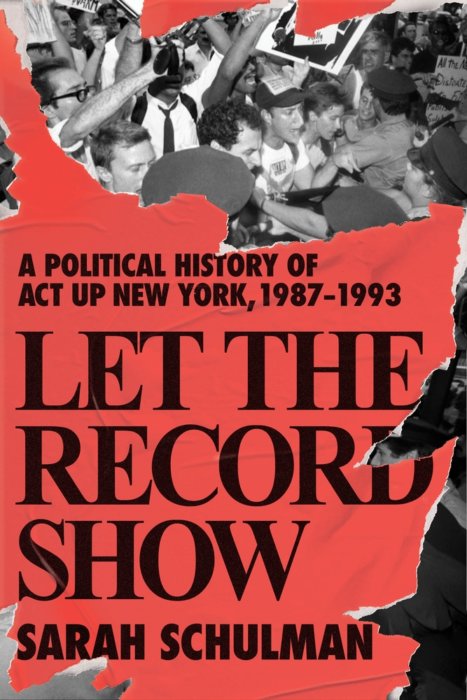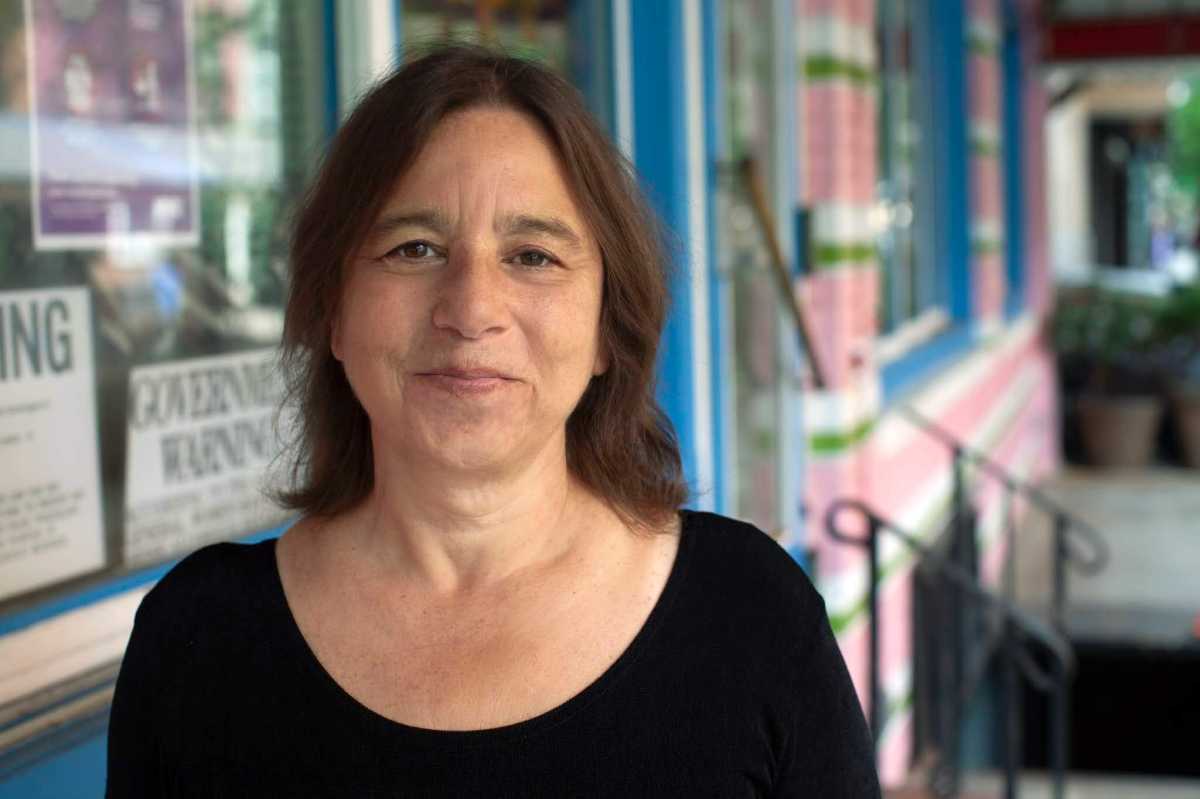The question immediately raised by Sarah Schulman’s monumental new book, “Let the Record Show: A Political History of ACT UP New York, 1987-1993,” is how she sustained the intellectual stamina to build a sprawling collection of nearly 200 individual oral histories and then lend coherence to what those activists’ experiences tell us about the fight against AIDS — and efforts, more generally, to make change in our society.
A distinguished professor in the English Department at CUNY’s College of Staten Island, Schulman is a prolific creator. The author of 11 novels, six nonfiction books, seven plays, and two screenplays, she was also the co-founder, with Jim Hubbard, of MIX: The New York Lesbian and Gay Experimental Film Festival and the co-producer of Hubbard’s 2012 documentary “United in Anger: A History of ACT UP.”
The 188 oral histories that Schulman draws from in “Let the Record Show” — all available online — are the product of her collaboration with Hubbard on the ACT UP Oral History Project, a labor that lasted from 2001 until she was finishing up her book in 2018.
One of the foundational insights of good HIV reporting is that there is no single AIDS epidemic — certainly not globally or across the United States, but not even in New York City or in Manhattan, Brooklyn, or the Bronx, for that matter. Schulman’s account makes abundantly clear that there was also no single ACT UP — either objectively or, crucially, in the subjective experiences of the diverse thousands who variously became civil disobedience activists, treatment and health policy experts, media spokespeople, public art agitators, and legal defenders.
Schulman’s primary aim is a political analysis informed by the direct testimonies of many dozens of the ACT UPers she interviewed, but in the process she also movingly evokes what the group meant personally in the lives of thousands who refused to be “bystanders” in the face of the AIDS catastrophe. Moisés Agosto-Rosario, a gay man who came to the city from Puerto Rico, said, “If it wouldn’t be for ACT UP, it would have taken me a long time to find a family of friends in New York.” For half a dozen gay white treatment activists, as recounted by David Barr, there was a weekly dinner rotating among their apartments for seven years that assured each of them, “We’ll all be with each other as we get sick and die.” Sharon Tramutola, a bisexual woman drawn to ACT UP when a friend got sick, recalled, “There were people that socialized in ACT UP who would never, ever, in a million years, if it wasn’t that situation, even talk to each other on the street.”
There were also the countless activists lost to AIDS over the years that Schulman chronicles, a “landscape of disappearance and apparition… I am trying to recapture here.”
Politically, Schulman has never shrunk from voicing strong, often controversial perspectives. In the book’s early pages, she takes direct aim at accounts of the epidemic she finds fundamentally false or misleading: from Tony Kushner’s “Angels in America” to David France’s “How to Survive a Plague” and Andrew Sullivan’s infamously premature 1996 Times Magazine cover story “When Plagues End.”

the history of ACT UP.FARRAR, STRAUS AND GIROUX
But her analysis of ACT UP’s politics is “not a game of call-out” — not simply because she painstakingly presents a wide array of opposing and often detail-conflicting perspectives, but also because her goal in highlighting the group’s unprecedented grassroots achievements as well as its weaknesses is part of a larger mission to inform social change efforts today, whether on healthcare access or transgender rights, systemic racism or police reform.
ACT UP, she acknowledges, was made up largely of white gay men — but it came to include, as well, many women, largely though not exclusively lesbians, people of color, injection drug users, and poor folks shut out of the healthcare system. That diversity was a source of strength — for example, the perspective longtime feminists brought from the reproductive rights and women’s health movements regarding the “patient-centered politics” I long mistakenly credited ACT UP as originating.
But the different backgrounds people brought into ACT UP and the correspondingly divergent reasons they arrived also sowed seeds of division — based on race, socioeconomic status, gender, and the inevitable disparities in privilege and access to power.
The word privilege is often wielded today as an accusation, but that’s not a pejorative frame Schulman finds useful to her analysis. The rage that led white gay men to respond to Larry Kramer’s famous call to arms at the LGBTQ Community Center in March 1987, in her telling and the accounts of many of her interviewees, was not based solely on the government’s neglect and discrimination but also on the shock of their powerlessness as white men accustomed to finding ways to wield influence.
That white male privilege had its political advantages for ACT UP. Looking back nearly 35 years from 2021, Schulman notes, it might be easy to forget the virtual lock on influence that white men in the US then played in government, corporate leadership, the criminal justice system, and the media. Peter Staley, a leader in the Treatment and Data Committee (T&D), might have had a flair for eye-grabbing civil disobedience — whether letting off a smoke bomb at the Food and Drug Administration (FDA) headquarters or dropping an enormous condom over the home of Republican arch-homophobe Jesse Helms — but when he put on a suit from his days as a Wall Street bond trader and drew on his education at Oberlin College and the London School of Economics he became someone government and pharmaceutical industry officials felt they could talk to.
Drawing on lessons borrowed from the Civil Rights Movement of the 1950s and ‘60s — when Black college students sat in at the lunch counters where they were denied service — venues like the FDA were perfect targets: ones that were not “generic,” but rather “actual. It had to be the exact building where the problem was being housed.”
That October 1988 action was an example of what Schulman described as an emerging insider/ outsider strategy. As different affinity groups carried out their own civil disobedience plans, media and public relations professionals like Ann Northrop and Michelangelo Signorile coolly corralled the swarm of reporters on hand to make sure they got the right message — so demonstrators, in Northrop’s formulation, could “speak through the media, not to the media.”
The group’s largest demonstration, which, Schulman estimated, drew 7,000 protesters, was the Stop the Church action at St. Patrick’s Cathedral in December 1989. Unlike other actions, there was no specific policy goal there, but it did directly confront the most “respectable” among America’s leading homophobes, Cardinal John O’Connor, who literally, in ACT UP’s view, got away with murder. When the action went further than anything the group had approved — with one protester tossing the Communion wafer on the ground and others yelling from the pews — the controversy went beyond mainstream outrage to bitter division within ACT UP itself. And yet it was likely the highest profile action ever taken.
An insider/ out approach was evident again when Staley and his treatment colleague Mark Harrington got meetings — “a very nice lunch” included — with pharma giant Burroughs Wellcome, maker of AZT, the most expensive drug in history, toxic as it was. Staley acknowledged that the “red carpet” treatment was due to the company’s “palpable fear” of the alternative — a disruptive protest by what Schulman terms “women, radicals, and people of color, the street activists.” When the price of AZT did not yield to earnest discussions, both the insiders and the outsiders swung into action, first infiltrating the Burroughs Wellcome headquarters and later the New York Stock Exchange. Three days after the Stock Exchange action, AZT’s price was cut 20 percent, the last time, according to Schulman, that an HIV drug saw a price reduction.
Over time, some of the outsiders — including women, people of color, and injection drug users — came to see the T&D members, largely gay white men, as too much out for themselves, looking for access to what could save their lives — while a third of ACT UP members had no health insurance. Agosto-Rosario looked up to the T&D leaders, but also saw that they could access more promising treatments than AZT earlier than others. In the end he concluded they “were not really that much into doing work related to access to care and treatment in disenfranchised communities.” When Robert Vázquez-Pacheco, a gay Black Nuyorican also concerned about healthcare access, was invited to join the Treatment Action Group — formed when key members of T&D broke away from ACT UP in 1992 — he found the setting “unfriendly.”
A big part of the dissatisfaction with ACT UP’s treatment activists was the view they were not fighting to broaden the demographic profile of those enrolled in drug clinical trials. Government researchers were looking to focus efforts on a homogenous population — specifically gay men, most of them white. Richard Elovich, a white gay man recovering from heroin addiction who led civil disobedience efforts that distributed clean needles to injection drug users, confronted Anthony Fauci, then as now director of the National Institute of Allergy and Infectious Diseases, about why users were barred from clinical trials. Fauci replied that as “a noncompliant population” drug users couldn’t be relied on to stick to a trial’s drug regimen. Elovich, “enraged” by the answer, came out to Fauci as a recovered addict.
More than any other group, it was women who were outspoken in their criticism of T&D. At the urging of Barr and Harrington, ACT UP voted to block women from protesting at a plenary session of the 1990 International AIDS Conference, saying they wanted to keep the lines of dialogue with researchers open. The science being discussed, the women activists volleyed back, was “not valid science,” since it excluded research on females. Rebecca Pringle Smith, who came to New York for a postgraduate pre-med program at Columbia, recalled that “this view got put out that… Fauci liked the men better because they were nice, and the women weren’t.” It took a four-year fight — carried out under the slogan “Women don’t get AIDS, we just die from it” — for the CDC to change the definition for an AIDS diagnosis to reflect the specific ways in which HIV breaks down their bodies, including cervical cancer, endocarditis, and bacterial pneumonia.
Without an AIDS diagnosis, women couldn’t access Social Security disability benefits as well as those available from the city’s Division of AIDS Services. Even with the change, Schulman writes, by 2001 all but one of the HIV-positive women in ACT UP had died.
The 1992 departure of T&D activists to form the Treatment Action Group was the culmination of the growing insider/ outsider tension at ACT UP — and, in Schulman’s view, a split that heralded the group’s declining vitality. Maxine Wolfe, a lesbian whose activist roots went back to 1960s feminism, is often painted as being at the opposite pole from Mark Harrington on the group’s outsider/ insider spectrum. Her critique of TAG was that its members were self-serving and had betrayed the underlying ACT UP vision by separating medicine from politics.
From David Barr’s perspective, the lengthy and often divisive fights treatment activists faced on the floor of ACT UP meetings increasingly took “all this time and energy” away from the an agenda “we were seeing a lot of success with.”
In describing the ACT UP-TAG split, Schulman writes, “I never took a side.” She clearly appreciates the frustration that women and others had toward the T&D members’ “telegraphing a feeling of superiority and disrespect.” At the same time, she points to the four years it took for women to get the definition of AIDS changed as providing “a resounding no” to the question of whether ACT UP could have made the significant treatment strides it did if it had been fronted by a different face.
“Demographics determined access,” she writes, “and access determined the playbook.”
Schulman’s observation is not meant to minimize what she views as ACT UP’s failure to have advanced treatment access more by the time the drugs that actually made HIV a manageable infection arrived in the mid-1990s.
And, regarding the impact of TAG’s departure, she writes, “We don’t know, if ACT UP had healed, if it could have become, created, or contributed to” a broader movement for universal healthcare.
ACT UP’s imperfect realization of its vision, Schulman clearly suggests, is its greatest lesson for activists today. Struggles for change have “to be driven by those people affected,” she writes, adding, “Democracy requires participation… This is what politics is.”
LET THE RECORD SHOW: A POLITICAL HISTORY OF ACT UP NEW YORK, 1987-1993 | By Sarah Schulman | Farrar, Straus and Giroux | $40; 702 pages



































